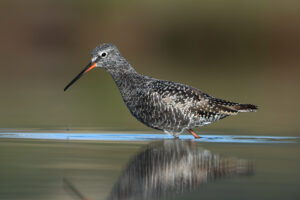Spotted Redshank
The European population is estimated at 20,000-45,000 pairs, wintering mainly on the Mediterranean coast and in the Sahel (Delany et al. 2009). At higher latitudes, the species breeds in tundra or open wetland habitats within the Taiga. The southernmost individuals breed in agricultural mosaics (Keller et al., 2020). Although the breeding numbers of the species remain small in the three Fenno-Scandinavian countries, there is evidence of negative dynamics of the species in the short to long term (Lindström et al. 2015). Excessive drainage of peatland in Finland could be one of the reasons for the decline of the species (Fraixedas et al. 2017). To our knowledge, the species is one of the least studied European shorebirds, and no telemetry monitoring has been carried out on it.

Spotted Redshank (Tringa erythropus) taken the 14/04/2024 at Hyeres - France
Loading
